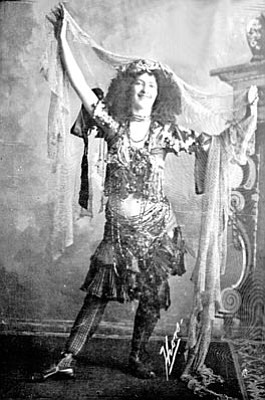By Parker Anderson
One of the most enduring legends in Prescott, handed down through the years by generations of old-timers, is that the famous belly-dancer, or rather, exotic dancer “Little Egypt,” who appeared live at the Palace bar in 1910. This story has been repeated often enough that few have ever questioned it.
Yet, the story of Little Egypt in Prescott has a surprising lack of corroborating evidence. No news clippings from 1910 (or any other year) have turned up placing her in Prescott for any reason. There are no surviving advertisements or eyewitness accounts. The story begs for further examination. What is the truth of the matter?
To begin with, historians of exotic dancing are in general agreement that there never was one single “Little Egypt.” In fact, large numbers of belly-dancers have used the name even to this day, making it somewhat of a cliché. Even today on the internet you can find dancers using the name “Little Egypt” seeking bookings. The name has become synonymous with exotic dancers.
The name of “Little Egypt” seems to have originated at the World’s Columbian Exposition in Chicago (the World’s Fair) in 1893. An attraction called “A Street in Cairo” presented a show titled “Algerian Dancers of Morocco.” There, a dancer named Farida Mazar Spyropoulos stole the show. Actually she was a Syrian, overweight and, because of her size, was nicknamed backstage as “Little Egypt.” The name stuck, although other similar dancers using the same name also appeared at the 1893 World’s Fair. It is Spyropoulos that Prescott legend places at the Palace in 1910. At that time she would have been nearly 40.
Another belly-dancer named Fatima Djemille (probably not her real name) also danced at the 1893 World’s Fair and reportedly used the name “Little Egypt.” She later appeared in short films by Thomas Edison demonstrating the belly dance. Another dancer named Ashea Wabe, going by the stage name of “Little Egypt,” was arrested by the vice squad in New York City in 1896 after dancing at a 5th Avenue bachelor party for the wealthy Herbert Seeley. There have been many others using this name. Author Donna Carlton wrote a book in the 1990s called ‘Looking for Little Egypt,’ in which she attempts to break down the national legends that there was a single famous dancer by this name.
So what about “Little Egypt” at the Palace in Prescott? The Sharlot Hall Museum Archives possesses a photograph (shown with this article) of an exotic dancer identified as “Little Egypt,” donated by an unknown person long ago because of the Palace legend. The woman in the undated photograph is certainly not Farida Mazar Spyropoulos, as she was quite obese, something that the 1893 World’s Fair attendees found very erotic when she would ‘shimmy and shake.’ The photo is clearly a publicity photo for the woman in the picture and was certainly not taken at the Palace bar. The photo could even be a business card for a prostitute for all we know – there were such things in the days when the Red Light districts were legal.
The Arizona Historical Foundation has a copy of this same photo and, while their files also identify the pictured woman as “Little Egypt,” their files simultaneously identify her as Grace Bartell. This adds to the mystery as there is no ready documentation as to the identity of Grace Bartell, if there was indeed such a person.
So it must be concluded at this point that the famous story of “Little Egypt” dancing at the Palace Bar is just an unproven legend. Any historian who could prove it would undoubtedly receive many accolades, and if anyone reading these words feels they can, please contact the Sharlot Hall Museum archives immediately at 445-3122.
Like most legends, this one may have started out with a kernel of truth. Perhaps an amateur dancer from somewhere in Arizona, or even Prescott itself, adopted the name and was booked at the Palace. Without any documentation, there isn’t any way to tell for sure. Another Arizona legend contends that “Little Egypt” performed regularly at the Bird Cage Saloon in Tombstone around this same time, but again, if it is true it is extremely unlikely that it would have been one of the above mentioned Little Egypts. Prominent, respectable performers did not appear at bars in those days as they do today.

Sharlot Hall Museum/Courtesy photo
Though this early 1900s photograph is labeled “Little Egypt,” the woman’s actual identity is uncertain. The original dancer using the title was Farida Mazar Spyropoulos at the 1893 World’s Fair in Chicago and is not the person in this photo.


